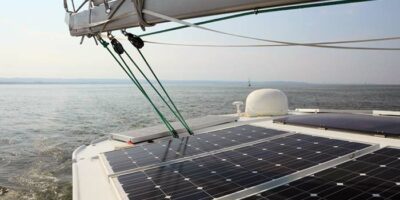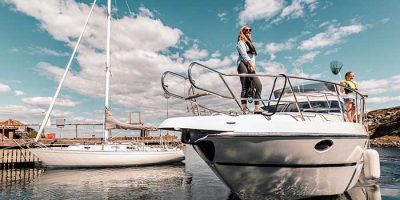I’ve never understood why so many vessels I inspect as a marine surveyor fail in their ability to comply with mandated navigational lighting requirements. I’d estimate the percentage is as high as 30% (or worse), an appalling rate when it comes to safety-related equipment. Imagine if your life jackets or fire extinguishers only worked 70% of the time when needed.
Most problems I see are maintenance issues (cloudy lenses, burned-out bulbs, broken wires), but an alarming number are improper initial installations by the manufacturer or blockage from aftermarket equipment installations by owners or dealers. It appears many either do not have a good understanding of the navigation rules governing installations or they shoot for (and miss) the bare minimum requirements, often at the expense of the end user.
Regardless of what the manufacturer did (or didn’t) do, it’s imperative to remember that when it comes to navigational lighting, it is your responsibility to ensure your boat complies with the rules. Here’s how to make sure your boat is ready for the nightlife.
General Requirements
It’s beyond the scope of this article to list every possible configuration or variation of lights, however, by way of example, a typical powerboat less than 65 feet while underway at night or in reduced visibility would require side lights, a masthead light, and a stern light. The side lights consist of a green light to starboard and a red light to port, both of which must cover an arc of the horizon (or sector) of 112.5 degrees visible from dead ahead to 112.5 degrees down each respective side.
The masthead light is a forward-facing white light on the vessel’s fore and aft centerline showing an unbroken arc of 225 degrees and fixed to show the light from dead ahead to 22.5 degrees abaft the beam on either side of the vessel. The stern light, also a white light, must be visible from dead astern for an arc of 135 degrees (67.5 degrees on either side of centerline). You’ll notice that adding the arc of visibility of the masthead and stern light yields 360 degrees, which is what they’re shooting for coverage-wise. Vessels less than 39.4 feet in length have the option of exhibiting a single 360-degree white light in lieu of a separate masthead and stern light. (As a practical matter, you should be sure that the optional single 360-degree light will not interfere with your night vision.) Vessels anchored at night or in reduced visibility are required to display a single all around white light visible for 360 degrees.
The Basics
All boats must have the ability to display required navigation lights while operating at night and during times of reduced or restricted visibility (such as fog or heavy rain). Required navigation light configurations are based on a number of factors, such as a vessel’s length, method of propulsion, or any special activity it’s engaged in (e.g., trawling, towing). The type, arc, and color of navigation lights allow observers to determine a vessel’s size, propulsion, and whether it’s anchored or moving (and if so, its course).
For example, if you look over your bow and see a red light followed by a white light, you can assume a vessel is crossing your path from starboard to port and (depending on distance) it is the stand-on vessel (meaning it has the right of way) and you would be the give-way vessel. A single white light visible 360 degrees, on the other hand, indicates an anchored vessel or possibly a vessel that is aground.
The first step in determining if your vessel is compliant is to consult a copy of U.S. Coast Guard COMDTINST M16672.2D, aka the “Rules of the Road.”
Inspections
Once you’ve consulted the Rules of the Road and determined your navigation lights meet the requirements, next up is a physical inspection to make sure they’re installed and operating properly. Start by turning on your running lights and then your anchor light, verifying in turn that each powers up and meets the visibility requirements mentioned in the Rules of the Road.
Look for issues such as the placement of equipment (e.g., dinghies, fenders, canvas) that could block visibility, burned-out bulbs, and poor lighting installations.
A good example of the latter is a masthead light that effectively blinds you when operating the vessel from the upper helm or fly bridge. Assume nothing and keep your eyes open for the unexpected, such as side light lenses (red port, green starboard) being reversed, a problem I’ve seen where lights have been replaced by well-meaning owners.
Sailboat owners may find it easier to verify the operation of mast-mounted navigation and anchor lights at night from the dock when they’re more easily visible.
Next, take a good look at the lights themselves. Are they damaged? Are they burning brightly or dim, a problem that can be caused by UV damage or “frosting” of the lens, installation of the wrong type of bulb, or a poor quality light. Dirty lenses or corroded electrical contacts and switches can also cause problems.
Installing LED Boat Navigation Lights
Distance visibility (how far your navigational lights can be seen) is crucial and can easily be a case where meeting the letter of the law doesn’t necessarily mean the spirit of the law has been satisfied. I’ve seen installations designed to meet the minimal requirements under perfect conditions (clear weather, minimal wave action) but fail miserably in less-than-ideal conditions, the very times you want to make sure you’re seen. Problems range from poor location of the navigation lights (flush mounted sidelights in the hull below the rubrail are a good example of this) to the lights themselves, which are often too small or simply pieces of junk to begin with.
Don’t be afraid to relocate factory-installed navigation lights to better comply with the requirements or replace them with brighter, more robust units. (If there is any question as to rule compliance or appropriateness of the lights, have an ABYC-qualified surveyor or other qualified person check them.) LED fixtures have become a popular choice, and the benefits are numerous — longer life (up to 100,000 hours in some cases), less power draw, sealed construction (eliminating corrosion), and not susceptible to damage from shock or vibration.
Do not, however, simply swap your incandescent navigation light bulbs with LED replacements. Navigation light fixtures are approved for use as a unit (i.e., bulb and fixture together), and simply swapping out the bulb of your current fixture does not mean the new combination will comply. Once you’ve verified everything is in good working order, record the types of bulbs required for all non-LED navigation lights and ensure you’ve got plenty of spares onboard.
Boat owners love lots of pretty lights, but you have to ensure that decorative light installations cannot be mistaken for navigation or law enforcement lights and that they don’t impair the visibility or distinctive character of approved and properly placed navigation lights. You also don’t want them to interfere with your ability to maintain a proper lookout. Haphazard installation of additional lighting must be avoided, and violations (resulting in fines or worse) can occur if those mood lights installed on your rig can be construed as a light required by the Rules for another vessel. For example, blue underwater LED lights can appear to be flashing if wave action is present, giving the appearance of a flashing blue light that only law enforcement vessels are authorized to use.
Finally, include checking the operation of all navigation lights as part of your predeparture checklist. It only takes a moment and you’ll be doing yourself (and everyone else on the water) a favor.
Frank Lanier
Contributor, BoatUS Magazine
About Vessel Vanguard
Vessel Vanguard is a leading marine safety and maintenance management software provider dedicated to revolutionizing the maritime industry. With a commitment to innovation and excellence, Vessel Vanguard delivers cutting-edge solutions to streamline operations and enhance vessel performance and safety.
Latest Industry Insights

Embracing E-Boating Efficiencies

Boat Fuel Systems

The Future of Boats & Boating

Yacht Navigation Light Inspection
View All of Our Industry Insights
Navigate maritime with the latest news, practical how-to guides, insightful analyses and more.
